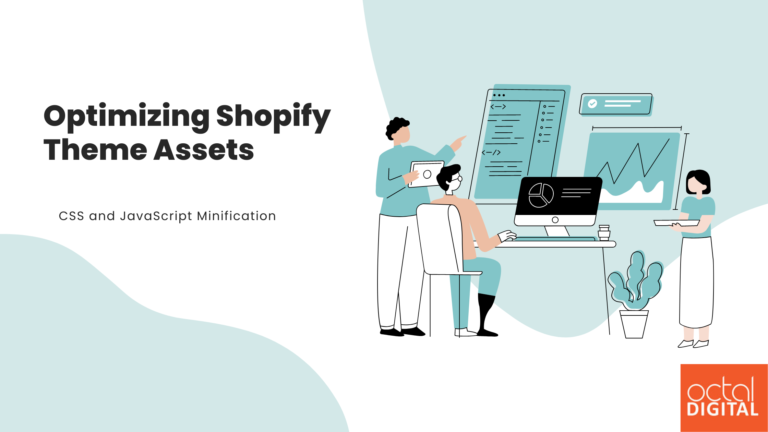Shopify store performance is intricately tied to the optimization of CSS and JavaScript assets. In this technical guide, we’ll explore how top Shopify store designers use advanced techniques for streamlining these assets, focusing on minification, compression, and asynchronous loading. By implementing these strategies, Shopify merchants can significantly enhance page load times, contributing to a more responsive and user-friendly online shopping experience.
CSS Optimization Techniques
Minification
Minification is the process of removing unnecessary characters and spaces from CSS files to reduce their size. In a Shopify theme, this can be achieved through automated tools or by leveraging built-in theme settings. For instance, the Shopify Online Store Editor often includes a minification option that condenses CSS files by eliminating comments, whitespace, and redundant characters, ultimately optimizing the stylesheet for faster loading.
Compression
To further optimize CSS assets during transmission, compression via Gzip can be employed. By configuring server settings to enable Gzip compression, Shopify merchants can significantly reduce the size of CSS files sent to users’ browsers. This technique is particularly effective in enhancing the efficiency of asset delivery over the network, contributing to improved page load performance.
Critical CSS
Critical CSS involves delivering the minimal amount of CSS required for above-the-fold content, prioritizing the rendering of essential elements. Tools like Critical by Addy Osmani or built-in Shopify theme features can be utilized to generate and implement critical CSS. This technique ensures that the initial visual rendering of the page is expedited, resulting in a faster-perceived loading time for users.
JavaScript Optimization Techniques
Minification
Similar to CSS, JavaScript files can be minified to reduce their size by removing unnecessary characters and spaces. Automated minification tools or Shopify-specific solutions can be applied to achieve this optimization. Top Shopify store designer also use “Shopify Online Store Editor” which offers options for automatic JavaScript minification, simplifying the process for merchants.
Compression
Compression techniques, such as Gzip, can be applied to JavaScript files to reduce their size during transmission. Configuring server settings to enable Gzip compression ensures that the compressed JavaScript assets are efficiently delivered to users, contributing to faster page loads. This is a fundamental practice for optimizing the performance of JavaScript-heavy Shopify stores.
Asynchronous Loading
Implementing asynchronous loading for non-essential JavaScript resources is a key strategy for enhancing page load speed. By leveraging Shopify theme practices and incorporating asynchronous loading code using JavaScript or the async attribute in script tags, developers can ensure that non-critical scripts do not block the rendering of the page. This technique is particularly beneficial in scenarios where certain scripts can be deferred without impacting the initial page display.
Combined Optimization Strategies
Asset Bundling
Asset bundling involves combining multiple CSS or JavaScript files into a single file to reduce the number of HTTP requests made by the browser. This can be achieved through automated bundling tools or features provided by Shopify themes. By minimizing the number of separate requests, asset bundling contributes to quicker page loads and an overall more streamlined browsing experience.
Lazy Loading
Lazy loading is a technique that defers the loading of non-critical assets, such as images or off-screen JavaScript, until they are needed. This can be implemented in a Shopify theme by utilizing the “loading” attribute for images or by incorporating JavaScript libraries that support lazy loading. By deferring the loading of non-essential resources, lazy loading optimizes the initial page load and improves subsequent interactions as users navigate through the site.
Testing and Performance Monitoring
Performance Testing Tools
Evaluate the impact of asset optimization using performance testing tools like Google PageSpeed Insights or Lighthouse. These tools provide detailed insights into various performance metrics, including Time to First Byte (TTFB), Total Blocking Time (TBT), and Cumulative Layout Shift (CLS). By interpreting these metrics, developers can assess the effectiveness of CSS and JavaScript optimization strategies and identify areas for further improvement.
Continuous Monitoring
Continuous monitoring is essential for identifying and addressing performance bottlenecks over time. Shopify-specific monitoring tools or third-party services can be employed to track changes in asset performance, ensuring that optimizations remain effective as the store evolves. Regularly monitoring and analyzing performance metrics contribute to the ongoing health and responsiveness of a Shopify store.
Conclusion
In conclusion, optimizing Shopify theme assets, specifically through CSS and JavaScript minification, compression, and asynchronous loading, is paramount for achieving peak performance and delivering an exceptional user experience. By implementing these advanced techniques, Shopify merchants can ensure their online stores are responsive, load quickly, and provide a seamless browsing experience for visitors. As the e-commerce landscape evolves, continuous attention to asset optimization remains a fundamental practice for staying competitive and meeting user expectations.
Revitalize your Shopify store with Octal Digital! We are the best Shopify store designer, with expert website developer Houston. Optimize your theme assets through CSS and JavaScript minification. Boost performance and enhance user experience.


